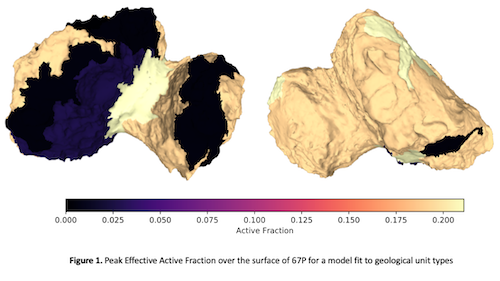Further constraints on activity models of comet 67P/Churyumov-Gerasimenko with Rosetta data
- 1Earth and Planetary Observation Centre, Faculty of Natural Sciences, University of Stirling, Stirling, UK (n.o.attree@stir.ac.uk)
- 2Aix-Marseille Université, CNRS, CNES, Laboratoire d’Astrophysique de Marseille, Marseille, France
- 3Southwest Research Institute, 1050 Walnut St, Suite 300, Boulder, CO, USA
Cometary outgassing produces a back-reaction force on a nucleus that can alter its trajectory and rotation state. Understanding this activity is key to exploring the physics of the upper layers of cometary surfaces, with implications for their formation and subsequent evolutionary history, and can be constrained by observing the orbit and rotation changes. For comet 67P/Churyumov-Gerasimenko, detailed measurements have been made by the Rosetta spacecraft and various attempts have been made to model the activity (see, e.g. [1,2]).
Here we will present updated work using the activity model of [2] to fit to Rosetta outgassing, trajectory, and rotation data. We test a number of different activity distributions over the surface of the comet by varying the Effective Active Fraction (EAF), relative to pure water ice, of facets on a shape model. The previous work has shown that, in order to fit the fast ramp-up and fall-off in outgassing either side of perihelion, 67P’s EAF must vary with time. We therefore investigate a number of different EAF curves to see if different parametric models can be ruled out. The objective here is to constraint the shape of the activity curve that a more advanced thermo-physical model (see, for example [3,4]) must produce in order to fit the data. We also investigate different spatial patterns in EAF, and attempt to correlate them to physical features on the cometary surface. Here we are able, for the first time, to achieve a good fit to the Rosetta data by parameterizing EAF in terms of the different geological unit types on 67P (Fig. 1). This may have important implications for understanding how activity works on the different types of surface observed on cometary nuclei, including ‘rough’, ‘smooth’, ‘dusty’ and ‘rocky’ surface morphologies. Finally, in addition to the changes in rotation period examined in [2], we also compute changes in the rotation axis in order to compare with the observations.

References
How to cite: Attree, N., Jorda, L., Groussin, O., and Marschall, R.: Further constraints on activity models of comet 67P/Churyumov-Gerasimenko with Rosetta data, Europlanet Science Congress 2020, online, 21 Sep–9 Oct 2020, EPSC2020-99, https://doi.org/10.5194/epsc2020-99, 2020.

